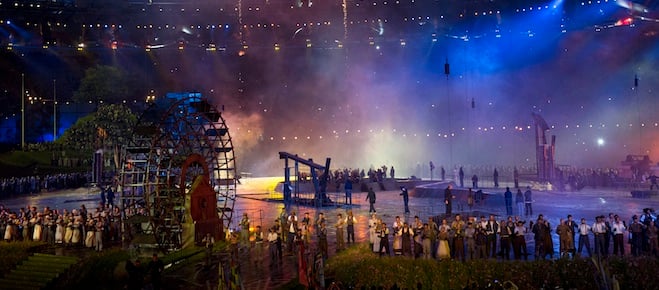Go easy on the gesamtkunstwerk
Trust the Germans to have precisely the word for the Olympic Opening Ceremonies
The Olympic rings come together over the stadium during the opening ceremonies for the 2012 Summer Olympics Friday, July 27, 2012 in London. THE CANADIAN PRESS/Sean Kilpatrick
Share
Trust the Germans to have precisely the word for something otherwise impossible to properly describe. In this case, what we want to describe is a work of art on a vast scale. And the word is an admittedly awkward, but handy, 15-letter handle, gesamtkunstwerk.
If you’re one of the approximately 1 billion people who paid any attention whatsoever to the Olympic opening ceremonies, you were watching an example of gesamtkunstwerk. Whatever you may think of the content (‘all over the place’ is probably a description both fans and critics can agree on), it’s worth noting that seeing such a spectacle, whether live or via the media, is a relatively rare occurrence.
The term gesamtkunstwerk—loosely translated as ‘total work of art’—is a fairly obscure bit of artspeak. It was used by Richard Wagner in the mid-19th century, to describe what he was attempting to do in his great operas: a synthesis of vocal music, orchestra, staging, costumes, dance, and architecture around a single mythic storyline.
Gesamtkunstwerk is the original multimedia. As a concept, it predates Wagner by millenia. From shamanic rituals incorporating masks, drumming, dance, and trance, to folk fertility dances in flowing costumes amid fresh flowers, to scented ceremonies of prayer and praise in mighty Gothic cathedrals, some version of gesamtkunstwerk has been with us for about as long as we humans have been expressing ourselves en masse.
In the 20th century, Wagner’s notions were put to use in a myriad of ways. Some were terrifying: spectacles surrounding mass demonstrations of military might, as in Nazi Germany (see Triumph of the Will), Soviet Russia, or contemporary North Korea, are gesamtkunstwerk. But so, one could argue, are the concerts performances of Pink Floyd, Madonna, Nine Inch Nails, or Katy Perry. So are Laurie Anderson‘s Home of the Brave, and Robert Wilson & Philip Glass‘s Einstein on the Beach. So are elements of the New Year’s Eve celebration in Times Square. Likewise, Brazil’s Carnaval. The sound & light show at Canada’s Parliament Buildings is an example of gesamtkunstwerk.
And so are the Olympic opening and closing ceremonies in the recent era. Gesamtkunstwerk. The same word that suited Wagner’s Ring Cycle suits this particular adoration of another sort of Rings just fine.
Calling something an example of gesamtkunstwerk is no guarantee of quality, mind you. Think of the accidentally flash-fried doves of Seoul, and the distressing Donny and Marie dinosaurs of Salt Lake, to name but a couple of wince-worthy moments. Canadians might rather forget the giant inflatable beavers taking centre stage in Vancouver to close the 2010 games. But how can we?
By such standards, the London 2012 Opening Ceremonies, ambitiously directed by Danny Boyle, deserve a great deal of credit.The mere scale of the endeavour is mind-blowing, for starters.
Anyone who attempts to sustain a storyline incorporating both the spirit of the Games and the beloved myths of a proud people, in front of all the world, in real time, in multiple media, all the while worrying about weather, logistics, and terrorism, has my deepest respect. I can barely sustain a line of thought long enough to tweet it.
Of course, like every ambitious work of art—and Olympic Ceremonies in particular, it seems—this particular gesamtkunstwerk includes the usual array questionable artistic decisions, not to mention culturally specific references.
Trivially, the mind reels as Mary Poppins vanquishes Voldemort; more seriously, I wonder why we seem to be celebrating the industrial age, and note the exclusion of the worst excesses of the British Empire.
But keep in mind what we’re looking at: a self-celebration the whole world is watching. A live spectacle grander than almost any other, one that includes video, music, dance, acting, comedy, setting, staging, lighting, elaborate mechanics, hundreds of volunteer participants, unseen workers galore, paratroopers, James Bond, Mr. Bean, the Royal Family, a Ferris wheel, a helicopter, and a vast parade. Not to mention multimedia contributions in real-time from the audience.
It’s an impressive thing to look at. It’s almost an impossible thing to imagine putting on, let alone more or less successfully. It’s a thing you rarely see, really. So while the first impulse may be to point and giggle, snicker and tweet… go easy. This is a worthy attempt at something glorious.
It deserves a solid name.
Gesamtkunstwerk. That’s what it is. Rings just about right, don’t you think?
